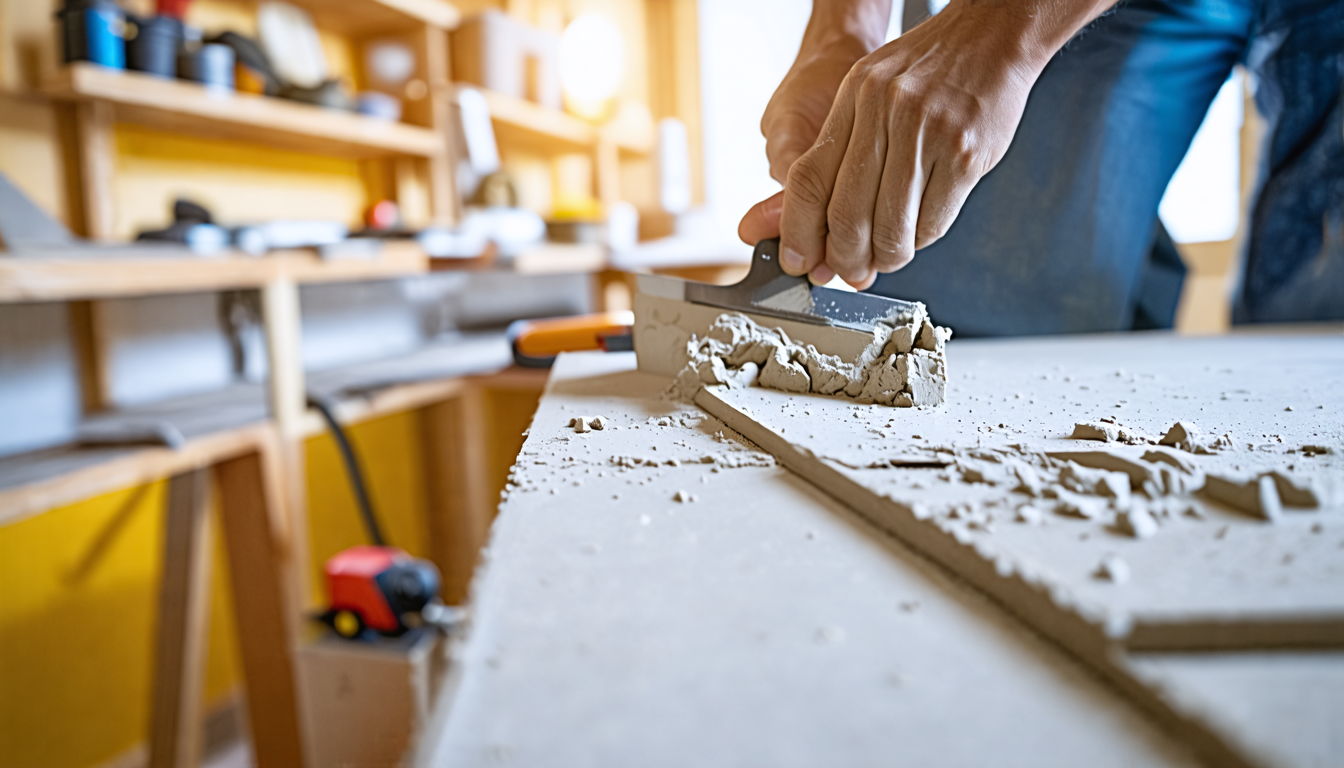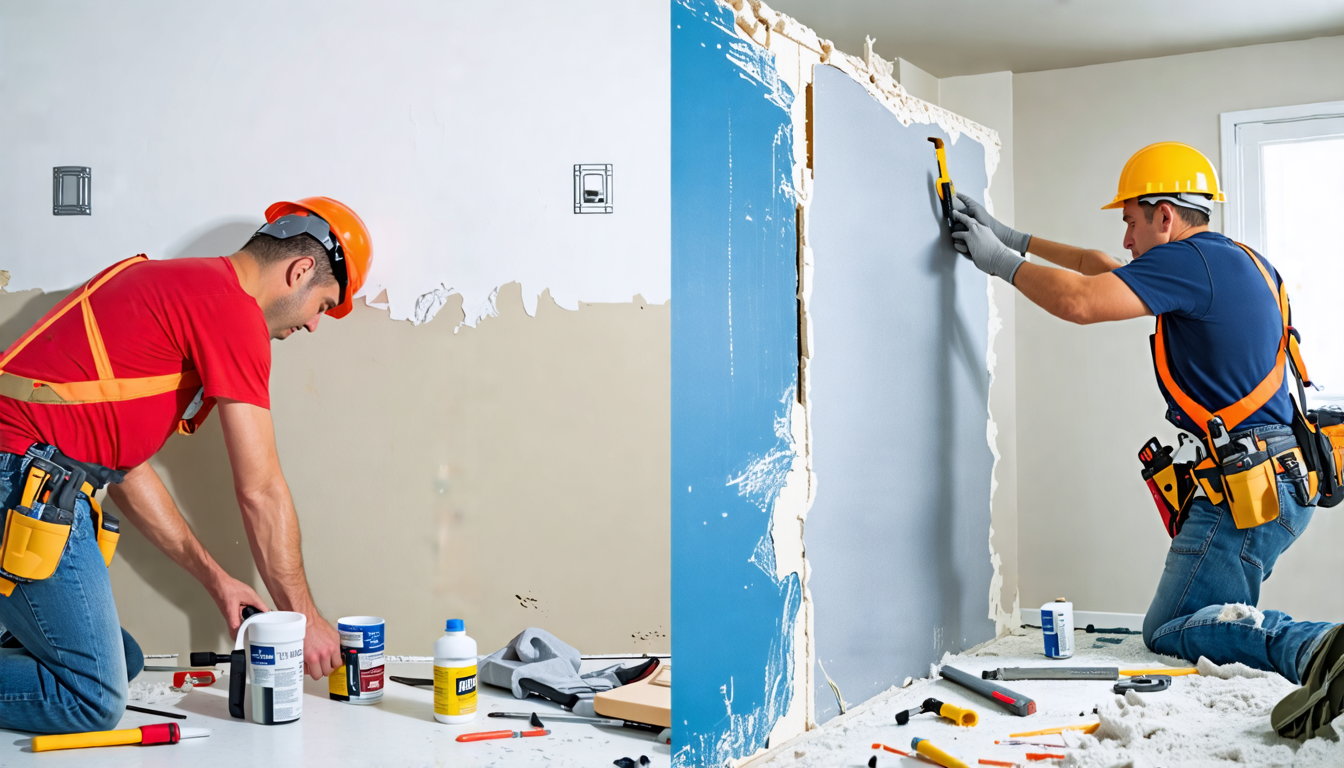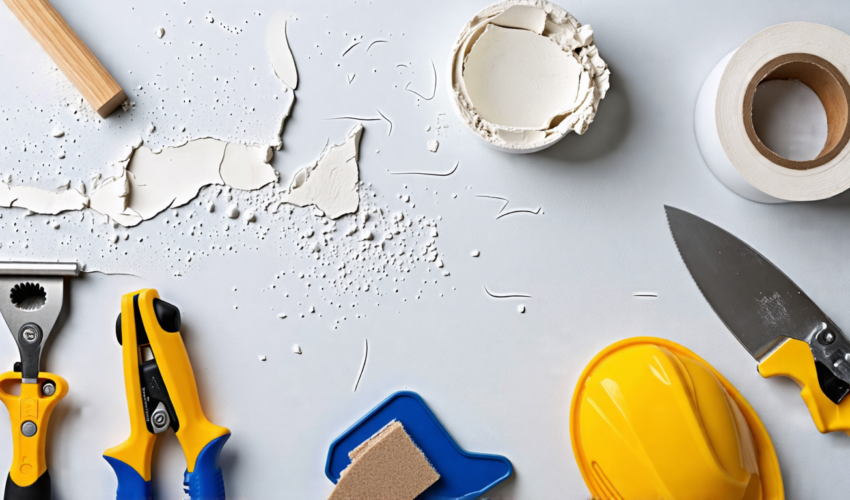Drywall is a vital component in modern home construction and maintenance, providing smooth, durable surfaces for interiors. However, its integrity can be compromised over time by issues such as holes, cracks, and water damage, each of which demands prompt attention to maintain the aesthetic and structural quality of your living space. Understanding efficient drywall repair is crucial for homeowners looking to preserve their walls’ function and appearance without incurring unnecessary expenses. In this article, we explore essential techniques that will equip you with the knowledge to tackle a range of drywall repair challenges effectively. Whether you’re dealing with minor cosmetic blemishes or significant structural concerns, mastering these techniques will enable you to restore your walls efficiently, minimizing both costs and time. As we delve into each aspect of drywall repair, you’ll gain insights into preparing your workspace, utilizing the right tools and materials, and achieving seamless finishes that blend effortlessly with your existing walls. By the end of this guide, you’ll be well-equipped to decide whether to undertake repairs yourself or seek professional assistance, ensuring the best outcome for your home improvement project.
Introduction to Drywall Repair
Drywall is a fundamental component in modern home construction, providing a smooth and aesthetically pleasing surface upon which interior design dreams are built. This ubiquitous material not only plays a crucial role in creating walls and ceilings but also aids in insulating and soundproofing homes, making it a cornerstone of modern housing architecture. Its practicality and ease of installation have made drywall a preferred choice among builders and homeowners alike, underscoring its importance in both new constructions and home refurbishments.
Despite its many advantages, drywall is not impervious to damage. Given its composition and function, it can suffer from a variety of common issues that necessitate repair. Among these, holes remain one of the most frequent drywall problems, often caused by doorknobs, furniture, or accidents that result in an unsightly breach of the wall surface. Additionally, cracks in drywall can occur due to settling of the house structure, thermal expansion, or even seismic activity, leading to aesthetic and structural concerns.
Water damage presents another significant challenge for drywall, whether resulting from plumbing leaks, roof drips, or high humidity levels within a home. If left unattended, water damage can compromise the integrity of drywall, leading to more extensive repairs and potential mold growth, which poses health risks to occupants. Therefore, recognizing and addressing these issues promptly is vital to maintain the quality and safety of your living environment.
To effectively manage these concerns, one must be equipped with essential techniques for efficient drywall repair. Employing correct procedures will not only restore the drywall’s appearance and function but also prevent future issues from escalating into expensive repairs. The ability to repair drywall efficiently ensures that projects are completed in a cost-effective manner with minimal disruption to the household. Meanwhile, high-quality repairs are nearly invisible, seamlessly blending into the surrounding wall surfaces for a professional finish.
As we delve into the task of drywall repair, understanding these foundational aspects sets the stage for mastering the techniques necessary to remedy these everyday issues. Through detailed, step-by-step guidance, it becomes feasible to transform damages into opportunities for skill enhancement and home improvement. Whether dealing with small holes, extensive damage, or complex issues, the right approach to drywall repair begins with recognizing the nature and scope of the problem. This initial assessment lays the groundwork for targeted, effective intervention, ensuring that repairs are sustainable and visually consistent with the existing décor.
In summary, drywall is an indispensable element of contemporary living spaces, susceptible to various forms of damage that require timely and competent repair. The imperative of mastering drywall repair techniques lies in safeguarding the aesthetic and functional integrity of one’s home while optimizing resource use. As we move to explore these techniques further, the principles established in this introductory overview will guide our efforts in achieving seamless and efficient repairs that stand the test of time.

When it comes to drywall repair, efficiency is paramount. Tackling common repair tasks with precision ensures that your walls look seamless and professional. This section will guide you through essential techniques to make your drywall repair project a success. From preparing the area to achieving a flawless finish, let’s explore the key steps involved in repairing drywall effectively.
Preparing the Area and Gathering Necessary Tools and Materials
Before beginning any drywall repair, proper preparation is crucial. Start by clearing the area and removing any furniture or decorations. Protect surrounding surfaces with drop cloths or plastic sheeting to avoid dust and debris spread. You’ll need specific tools and materials, such as:
- Utility knife
- Sandpaper or sanding block
- Joint compound
- Patching material or mesh tape
- Drywall saw
- Putty knife
- Primer and paint matching your existing wall color
Having all the tools and materials organized ensures a smoother process and minimizes potential interruptions.
Techniques for Repairing Small Holes
Small holes, like those from nails or screws, are common drywall issues that can be swiftly addressed. To repair these, a simple patch kit can be immensely helpful. Here’s how:
- Clean the Hole: Use a utility knife or sandpaper to scrape around the hole, removing any loose debris.
- Apply Joint Compound: Using a putty knife, apply a thin layer of joint compound over the hole, ensuring it’s level with the wall surface.
- Use Patch Kit: For holes larger than a quarter-inch, apply a patch kit over the compound. Smooth out air bubbles and feather the edges.
- Finishing Touches: Once dry, sand the area to ensure it’s smooth. Apply primer and then paint to match the existing wall color.
Step-by-Step Guide for Fixing Large Drywall Damage
Repairs for large holes or significant damage require a bit more effort. Follow these steps to replace and refinish large sections:
- Cut Out the Damaged Area: Use a drywall saw to remove the damaged section, cutting along the edges of the studs for stability.
- Measure and Cut New Drywall: Measure the hole dimensions and cut a new piece of drywall to fit snugly into the space.
- Attach the Drywall: Secure the drywall patch to the studs with screws, ensuring it is flush with the surrounding drywall.
- Appling Joint Tape and Compound: Place mesh tape over the seams and apply a layer of joint compound, feathering it outwards.
- Sand and Finish: Once the compound is dry, sand the area until smooth. Apply a second coat of compound if necessary, followed by sanding, priming, and painting.
These steps ensure that large repairs look as seamless as possible, blending naturally with the existing wall.
Tips for Achieving a Seamless Finish
To ensure your drywall repairs are virtually undetectable, consider these tips:
- Feather Your Edges: Feather the joint compound out several inches past the patch to aid in blending.
- Use a Light Touch When Sanding: Apply gentle pressure to avoid creating indentations or uneven areas.
- Match Textures: If your wall has a specific texture, use texturing spray or brushes to replicate it over the repaired area.
- Careful Painting: Use a high-quality primer and color-matched paint to ensure the new area blends with your existing wall.
The Importance of Efficiency in Drywall Repair
Efficiency in drywall repair not only saves time but also minimizes costs. By mastering these techniques, you’ll be able to tackle repairs quickly and with confidence. Preparing in advance, using the right tools, and applying attention to detail all contribute to a successful repair project, keeping your home looking pristine without unnecessary expense.

DIY vs. Professional Drywall Repair: Making the Right Choice
When faced with the decision of how to address drywall repair, homeowners typically consider two options: tackling the repair as a DIY project or hiring a professional service. Each option has its own set of advantages and challenges, often influenced by factors such as the complexity of the repair and the homeowner’s skill level. Understanding these nuances is crucial in making an informed decision, ensuring that the drywall repair process is not only effective but also cost-efficient and satisfactory.
Exploring the Pros and Cons of DIY Drywall Repair
For many homeowners, the idea of doing drywall repair themselves is appealing. DIY projects can be immensely rewarding, offering not only the satisfaction of completing the task but also potential savings on labor costs. Here are some key considerations:
- Pros:
- Cost Savings: DIY drywall repair can significantly reduce expenses, mainly limiting costs to materials and tools, which you might already have.
- Flexibility and Convenience: Working on your own schedule allows you to plan drywall repairs around personal commitments.
- Skill Development: Attempting drywall repair can be a great learning experience, enhancing your home maintenance skills.
- Cons:
- Skill Level Required: Successful drywall repair requires a certain level of expertise, especially for tasks like refinishing or addressing large holes.
- Time Consumption: DIY efforts can often take longer than anticipated, especially for those unfamiliar with the process.
- Quality of Finish: Amateur repairs might not blend seamlessly with the existing wall, affecting the overall aesthetic.
Scenarios Where Professional Drywall Repair Services Are More Efficient
Despite the allure of DIY projects, there are situations where professional drywall repair services are the much wiser choice. In certain cases, the expertise and efficiency offered by professionals can far outweigh the perceived savings of a DIY approach. Consider the following scenarios:
- Extensive Damage: When faced with significant damage, such as large holes or areas affected by severe water damage, professional services ensure quick and proper restoration to prevent further complications.
- Complex Repairs: Repairs that require precision, like matching specific textures or refinishing extensive sections, are best left to the experts who have specialized tools and experience.
- Time Constraints: For individuals with limited time, a professional service can quickly and efficiently complete repairs, minimizing disruption to daily life.
Advice on Selecting a Drywall Repair Professional
If opting for professional drywall repair, selecting the right service provider is paramount to achieving the desired results. Here are several factors to consider when choosing a professional:
- Check Reviews and Recommendations: Online reviews and recommendations from friends or family provide insights into a professional’s reputation and reliability.
- Verify Credentials and Experience: Ensure that the service provider is licensed and has substantial experience in drywall repair, ideally showcasing previous work or references.
- Request Detailed Quotes: Obtain quotes from multiple professionals to compare costs and understand exactly what services are included.
Ultimately, the decision between DIY and professional drywall repair depends largely on the nature of the repair and the homeowner’s confidence in tackling the task. By thoroughly considering the advantages and challenges of each option, along with the specific circumstances of the repair, homeowners can make informed decisions that best suit their needs.
Whether opting for a DIY approach or seeking professional assistance, the ultimate goal is to ensure the return of a flawless surface. This decision-making process, when coupled with thorough planning and consideration, ensures that drywall repair is not only efficient but also enhances the overall integrity and appearance of your home.
In conclusion, drywall repair is an essential aspect of maintaining the structural integrity and aesthetic appeal of a home. Understanding the common issues that necessitate repair, such as holes, cracks, and water damage, is crucial for adequately addressing them. The techniques outlined in this article provide a comprehensive approach to efficient drywall repair, from preparing the area and gathering the necessary tools to mastering the methods for both small and large repairs. Achieving a seamless finish is vital for blending the repairs with existing wall surfaces, ensuring that the patched areas are virtually undetectable. Efficiency is key, not only for reducing costs and time but also for achieving a high-quality result.
When deciding between DIY and professional drywall repair, homeowners must weigh the pros and cons. DIY repairs can be cost-effective and rewarding for those with the necessary skills and confidence. However, for complex repairs or those lacking experience, hiring a professional can ensure the job is done correctly and efficiently. Selecting a reliable drywall repair professional involves checking reviews and verifying credentials to ensure quality service. Ultimately, successful drywall repair, whether undertaken independently or by professionals, relies on careful planning, the right techniques, and attention to detail. By adhering to these guidelines, homeowners can effectively maintain their drywall, contributing to the overall health and appearance of their living spaces.

